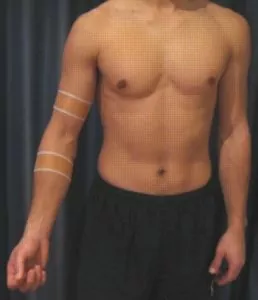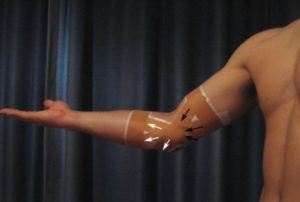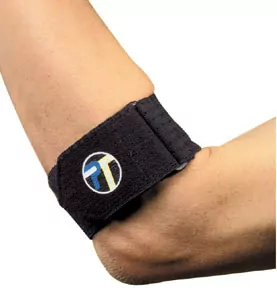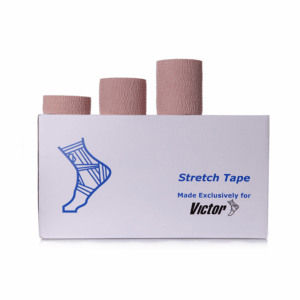Elbow Taping
Updated:
The following elbow taping techniques are designed to support and reduce stress on the elbow during activity. They can be used for both the treatment and prevention of elbow injuries and may be particularly useful for patients with an MCL tear or LCL tear of the elbow.
You should discuss the suitability of these taping techniques with your physiotherapist prior to using them. Generally, they should only be applied provided they are comfortable and do not cause an increase in pain, discolouration, pins and needles, numbness, swelling, itchiness or excessive redness of the elbow, forearm or hand.
What sort of tape should be used to tape my elbow?
There are many different tapes and bandages available for use by physiotherapists and patients. However, when the purpose is to support the elbow, 38mm adhesive, non-stretch (rigid) sports tape is usually the most appropriate. This should always be used in combination with hypoallergenic tape as an underlay, such as Fixomull.
Benefits of Elbow Taping
When used correctly, elbow taping can be used to:
- Decrease pain during sport or activity
- Aid healing of certain elbow injuries (such as an MCL tear, biceps tendonitis of the elbow, LCL tear, elbow sprain, etc)
- Allow an earlier return to sport or activity following injury
- Reduce the likelihood of injury aggravation
- Prevent the recurrence of elbow injuries (such as an MCL tear) during high-risk sports or activities (such as throwing sports etc.)
Indications for Elbow Taping
It is generally beneficial to use elbow taping techniques in the following instances:
- With certain elbow injuries – such as an MCL tear of the elbow (this should be discussed with the treating physiotherapist as certain elbow injuries should not be taped, such as some fractures).
- To prevent injury recurrence or injury aggravation – Elbow taping may be beneficial during sports or activities that place the elbow at risk of injury or injury aggravation (such as throwing or tackling sports etc.) especially in patients with a past history of elbow injury.
When should I avoid Elbow Taping?
Elbow taping should be avoided in the following instances:
- If you have certain injuries, such as some fractures (this should be discussed with the treating physiotherapist)
- If you have a skin allergy to sports tape
- If the taping technique results in an increase in symptoms such as pain, ache, itchiness, discolouration, pins and needles, numbness, swelling or excessive redness of the elbow, forearm or hand.
- If you have sensory or circulatory problems
Weaning off elbow tape in general activity is usually recommended as strength and flexibility improve and symptoms reduce. In these instances though, taping during high-risk activity (such as some sports) is usually still recommended.
Elbow Taping
The following elbow taping techniques may be used to provide support to the elbow. Generally it is recommended that the elbow is shaved 12 hours prior to taping (to prevent painful removal of hairs and skin irritation). The skin should be cleaned and dried, removing any grease or sweat. Low irritant Fixomull tape should be applied as an underlay to reduce the likelihood of skin irritation with rigid sports tape over the top of this.
Anchors
Keeping the elbow in a slight bend, tape around the upper arm and forearm, just above and below the elbow (figure 1). Keep the arm and forearm muscles contracted during this process and apply the tape gently to prevent circulatory problems. Anchors are used as a fixation point for other taping techniques.

Medial Crosses
Keeping the elbow in a slight bend (approximately 30 degrees), start the tape at the level of the arm anchor on the inner aspect of the elbow by following the black arrows (figure 2). Conclude this taping technique at the level of the forearm anchor by firmly following the white arrows (figure 2). 3 pieces of tape should be used forming a cross (figure 2). Do 1 – 2 medial crosses depending on the amount of support required.

Lateral Crosses

Members Only ContentBecome a PhysioAdvisor Member to gain full access to this exclusive content. For more details see Become a Member. Already a member? Login Now
Straight Lines

Members Only ContentBecome a PhysioAdvisor Member to gain full access to this exclusive content. For more details see Become a Member. Already a member? Login Now
Elbow Taping for an MCL tear
The following is a general recipe that may be used by physiotherapists to provide support to the MCL (Medial Collateral Ligament) following injury and to prevent MCL injury:
- Arm Anchor x 1
- Forearm Anchor x 1
- Medial Crosses x 1 – 2
- Repeat Arm Anchor x 1
- Repeat Forearm Anchor x 1
Elbow Taping for an LCL tear

Members Only ContentBecome a PhysioAdvisor Member to gain full access to this exclusive content. For more details see Become a Member. Already a member? Login Now
Elbow Taping for Complete Support

Members Only ContentBecome a PhysioAdvisor Member to gain full access to this exclusive content. For more details see Become a Member. Already a member? Login Now
Removing the tape
Care should be taken when removing the tape to avoid injury aggravation or skin damage. Blunt Nosed Tape Scissors should be used. The tape should be removed slowly, pulling the tape back on itself with pressure placed on the skin as close as possible to the line of attachment of the tape.Generally tape should be removed within 48 hours of tape application or sooner if there is any increase in pain or symptoms (including skin irritation or itchiness).
Elbow Taping Summary

Members Only ContentBecome a PhysioAdvisor Member to gain full access to this exclusive content. For more details see Become a Member. Already a member? Login Now
 Physiotherapy Products for Elbow Taping
Physiotherapy Products for Elbow Taping
To purchase physiotherapy products to assist with elbow strapping click on one of the above links or visit the PhysioAdvisor Shop.
 Elbow Exercises
Elbow Exercises
 Other Taping Techniques
Other Taping Techniques
 Find a Physio
Find a Physio
Find a physiotherapist in your local area who can help with taping an elbow.
 More Information
More Information
- Read about an MCL Tear.
- Read about an Biceps Tendonitis of the elbow.
Become a PhysioAdvisor Member
-
 Individual Membership (12 Months)$59.95 for 1 year
Individual Membership (12 Months)$59.95 for 1 year -
 Individual Membership (3 Months)$39.95 for 3 months
Individual Membership (3 Months)$39.95 for 3 months -
 Individual Membership (Yearly)$49.95 / year
Individual Membership (Yearly)$49.95 / year -
 Individual Membership (Monthly)$15.95 / month
Individual Membership (Monthly)$15.95 / month

Link to this Page
If you would like to link to this article on your website, simply copy the code below and add it to your page:
<a href="https://physioadvisor.com.au/health/taping-techniques-upper-body/elbow”>Elbow Taping – PhysioAdvisor.com</a><br/>PhysioAdvisor offers quality physiotherapy information on elbow taping and elbow strapping techniques for elbow injuries.
Return to the top of Elbow Taping.







